ECO mode MAZDA MODEL CX-9 2021 Owners Manual
[x] Cancel search | Manufacturer: MAZDA, Model Year: 2021, Model line: MODEL CX-9, Model: MAZDA MODEL CX-9 2021Pages: 723, PDF Size: 10.61 MB
Page 4 of 723
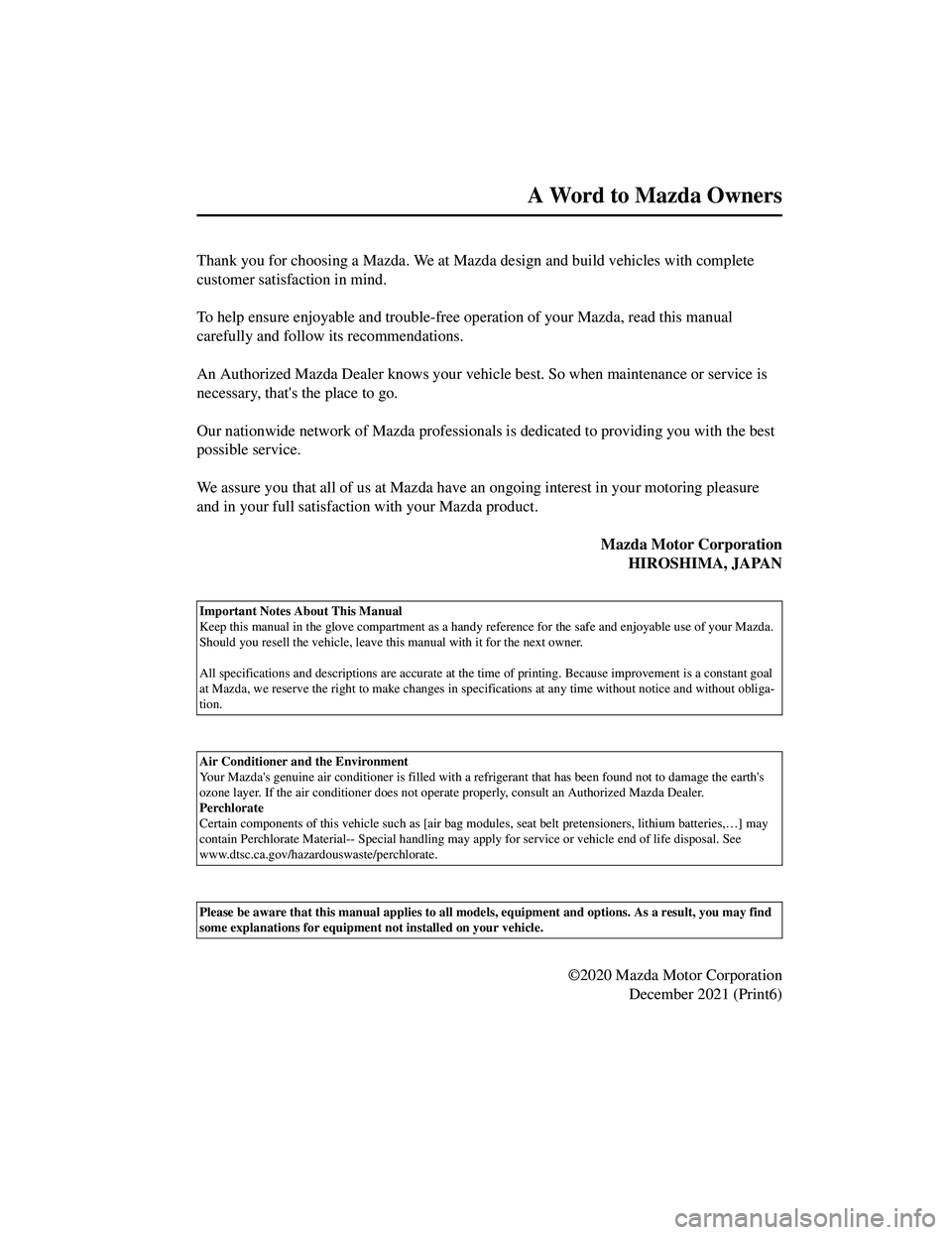
Thank you for choosing a Mazda. We at Mazda design and build vehicles with complete
customer satisfaction in mind.
To help ensure enjoyable and trouble-free operation of your Mazda, read this manual
carefully and follow its recommendations.
An Authorized Mazda Dealer knows your vehicle best. So when maintenance or service is
necessary, that's the place to go.
Our nationwide network of Mazda professionals is dedicated to providing you with the best
possible service.
We assure you that all of us at Mazda have an ongoing interest in your motoring pleasure
and in your full satisfaction with your Mazda product.
Mazda Motor Corporation
HIROSHIMA, JAPAN
Important Notes About This Manual
Keep this manual in the gl ove compartment as a handy reference for th e safe and enjoyable use of your Mazda.
Should you resell the vehicle, leave th is manual with it for the next owner.
All specifications and descriptions are accurate at the time of printing. Because impr ovement is a constant goal
at Mazda, we reserve the right to ma ke changes in specifications at any time without notice and without obliga ‐
tion.
Air Conditioner and the Environment
Your Mazda's genuine air conditioner is filled with a refrigerant that has been found not to damage the earth's
ozone layer. If the air conditione r does not operate properly, cons ult an Authorized Mazda Dealer.
Perchlorate
Certain components of this vehicle su ch as [air bag modules, seat belt pretensioners, lithium batteries,…] may
contain Perchlorate Material-- Special handling may a pply for service or vehicle end of life disposal. See
www.dtsc.ca.gov/hazardouswaste/perchlorate.
Please be aware that this manual applies to all mode ls, equipment and options. As a result, you may find
some explanations for equipment not installed on your vehicle.
©2020 Mazda Motor CorporationDecember 2021 (Print6)
A Word to Mazda Owners
CX-9_8JK1-EA-20G_Edition6_old 2021-12-8 9:30:44
Page 14 of 723
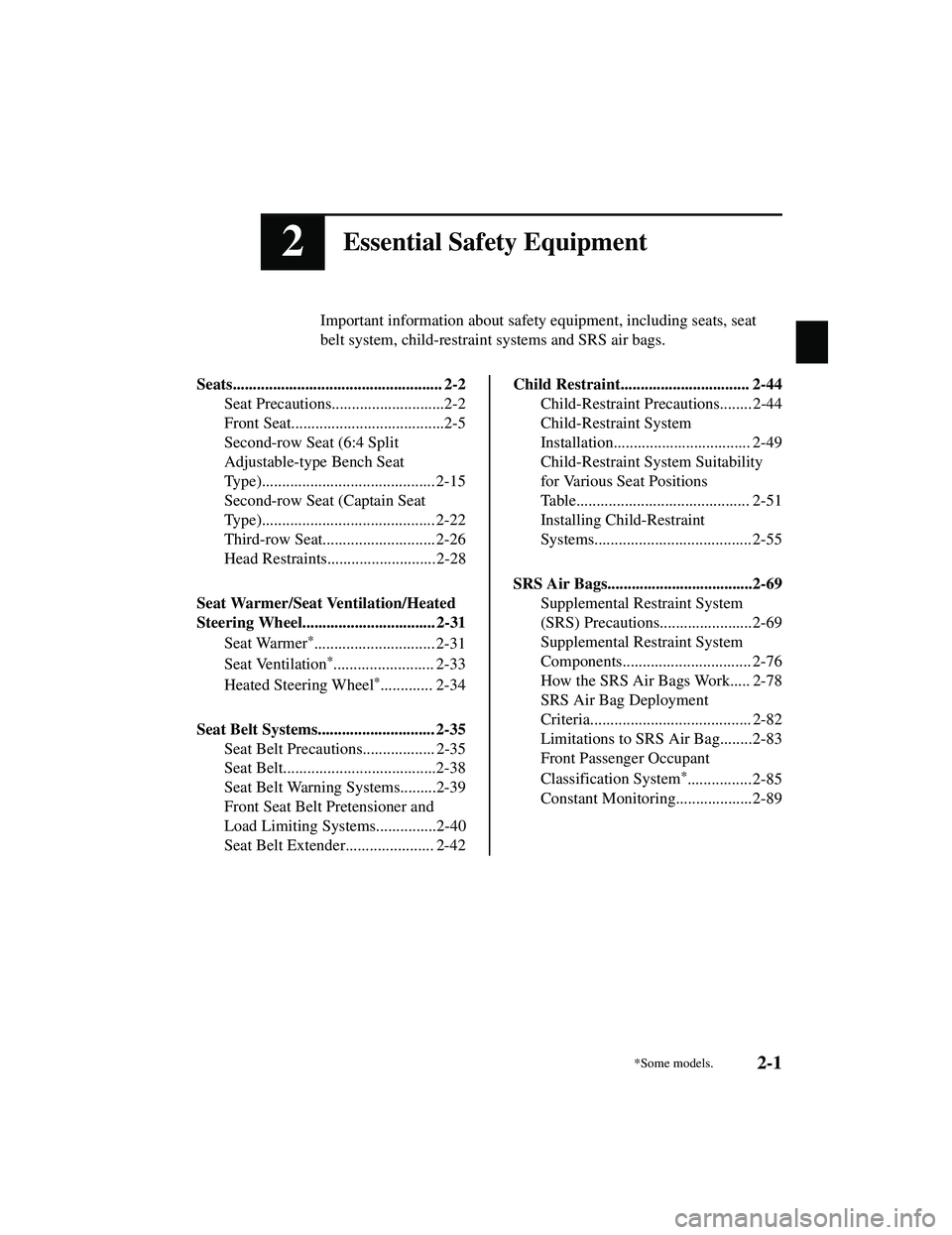
2Essential Safety Equipment
Important information about safety equipment, including seats, seat
belt system, child-restraint systems and SRS air bags.
Seats.................................................... 2-2 Seat Precautions............................2-2
Front Seat......................................2-5
Second-row Seat (6:4 Split
Adjustable-type Bench Seat
Type)........................................... 2-15
Second-row Seat (Captain Seat
Type)........................................... 2-22
Third-row Seat............................ 2-26
Head Restraints...........................2-28
Seat Warmer/Seat Ventilation/Heated
Steering Wheel................................. 2-31 Seat Warmer
*.............................. 2-31
Seat Ventilation
*......................... 2-33
Heated Steering Wheel
*............. 2-34
Seat Belt Systems.. ........................... 2-35
Seat Belt Precautions.................. 2-35
Seat Belt......................................2-38
Seat Belt Warning Systems.........2-39
Front Seat Belt Pretensioner and
Load Limiting Systems...............2-40
Seat Belt Extender...................... 2-42
Child Restraint................................ 2-44
Child-Restraint Precautions........ 2-44
Child-Restraint System
Installation.................................. 2-49
Child-Restraint Sy stem Suitability
for Various Seat Positions
Table........................................... 2-51
Installing Child-Restraint
Systems....................................... 2-55
SRS Air Bags....................................2-69 Supplemental Restraint System
(SRS) Precautions.......................2-69
Supplemental Restraint System
Components................................ 2-76
How the SRS Air Bags Work..... 2-78
SRS Air Bag Deployment
Criteria........................................ 2-82
Limitations to SRS Air Bag........2-83
Front Passenger Occupant
Classification System
*................2-85
Constant Monitoring...................2-89
*Some models.2-1
CX-9_8JK1-EA-20G_Edition6_old 2021-12-8 9:30:44
Page 19 of 723
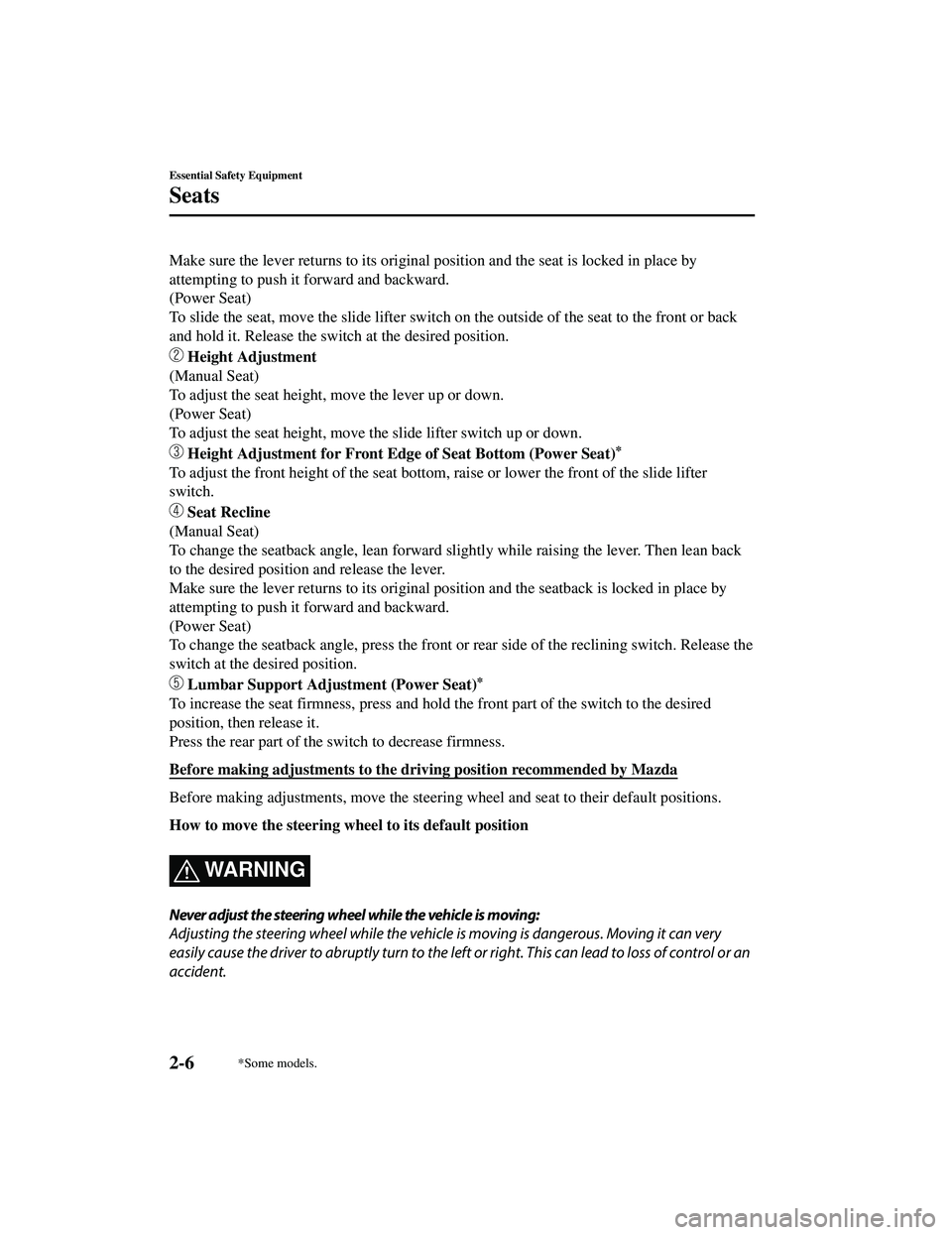
Make sure the lever returns to its original position and the seat is locked in place by
attempting to push it forward and backward.
(Power Seat)
To slide the seat, move the slide lifter switch on the outside of the seat to the front or back
and hold it. Release the switch at the desired position.
Height Adjustment
(Manual Seat)
To adjust the seat height, move the lever up or down.
(Power Seat)
To adjust the seat height, move the slide lifter switch up or down.
Height Adjustment for Front Edge of Seat Bottom (Power Seat)*
To adjust the front hei ght of the seat bottom, raise or lower the front of the slide lifter
switch.
Seat Recline
(Manual Seat)
To change the seatback angle, lean forward sl ightly while raising the lever. Then lean back
to the desired position and release the lever.
Make sure the lever returns to its original po sition and the seatback is locked in place by
attempting to push it forward and backward.
(Power Seat)
To change the seatback angle, press the front or rear side of the reclining switch. Release the
switch at the desired position.
Lumbar Support Adju stment (Power Seat)*
To increase the seat firmness, press and hold the front part of the switch to the desired
position, then release it.
Press the rear part of the switch to decrease firmness.
Before making adjustments to the driving position recommended by Mazda
Before making adjustments, move the steerin g wheel and seat to their default positions.
How to move the steering wheel to its default position
WA R N I N G
Never adjust the steering wheel while the vehicle is moving:
Adjusting the steering wheel while the vehicle is moving is dangerous. Moving it can very
easily cause the driver to abruptly turn to the left or right. This can lead to loss of control or an
accident.
Essential Safety Equipment
Seats
2-6*Some models.
CX-9_8JK1-EA-20G_Edition6_old 2021-12-8 9:30:44
Page 29 of 723
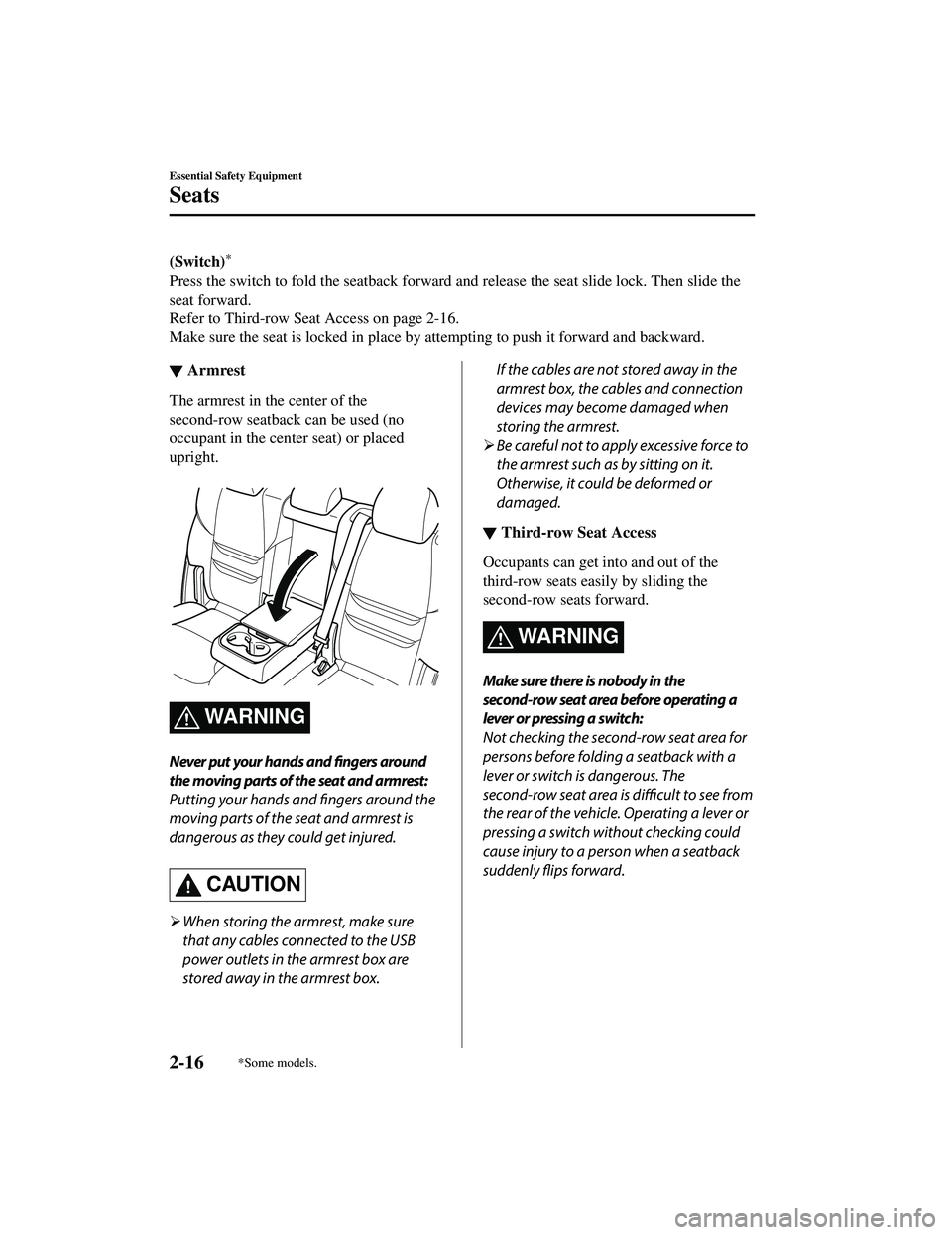
(Switch)*
Press the switch to fold the seatback forward and release the seat slide lock. Then slide the
seat forward.
Refer to Third-row Seat Access on page 2-16.
Make sure the seat is locked in place by attempting to push it forward and backward.
▼ Armrest
The armrest in the center of the
second-row seatback can be used (no
occupant in the center seat) or placed
upright.
WA R N I N G
Never put your hands and fingers around
the moving parts of the seat and armrest:
Putting your hands and fingers around the
moving parts of the seat and armrest is
dangerous as they could get injured.
CAUTION
When storing the armrest, make sure
that any cables connected to the USB
power outlets in the armrest box are
stored away in the armrest box.
If the cables are not stored away in the
armrest box, the cables and connection
devices may become damaged when
storing the armrest.
Be careful not to apply excessive force to
the armrest such as by sitting on it.
Otherwise, it could be deformed or
damaged.
▼ Third-row Seat Access
Occupants can get into and out of the
third-row seats easily
by sliding the
second-row seats forward.
WA R N I N G
Make sure there is nobody in the
second-row seat area before operating a
lever or pressing a switch:
Not checking the second-row seat area for
persons before foldin g a seatback with a
lever or switch is dangerous. The
second-row seat area is difficult to see from
the rear of the vehicle. Operating a lever or
pressing a switch without checking could
cause injury to a person when a seatback
suddenly flips forward.
Essential Safety Equipment
Seats
2-16*Some models.
CX-9_8JK1-EA-20G_Edition6_old 2021-12-8 9:30:44
Page 44 of 723
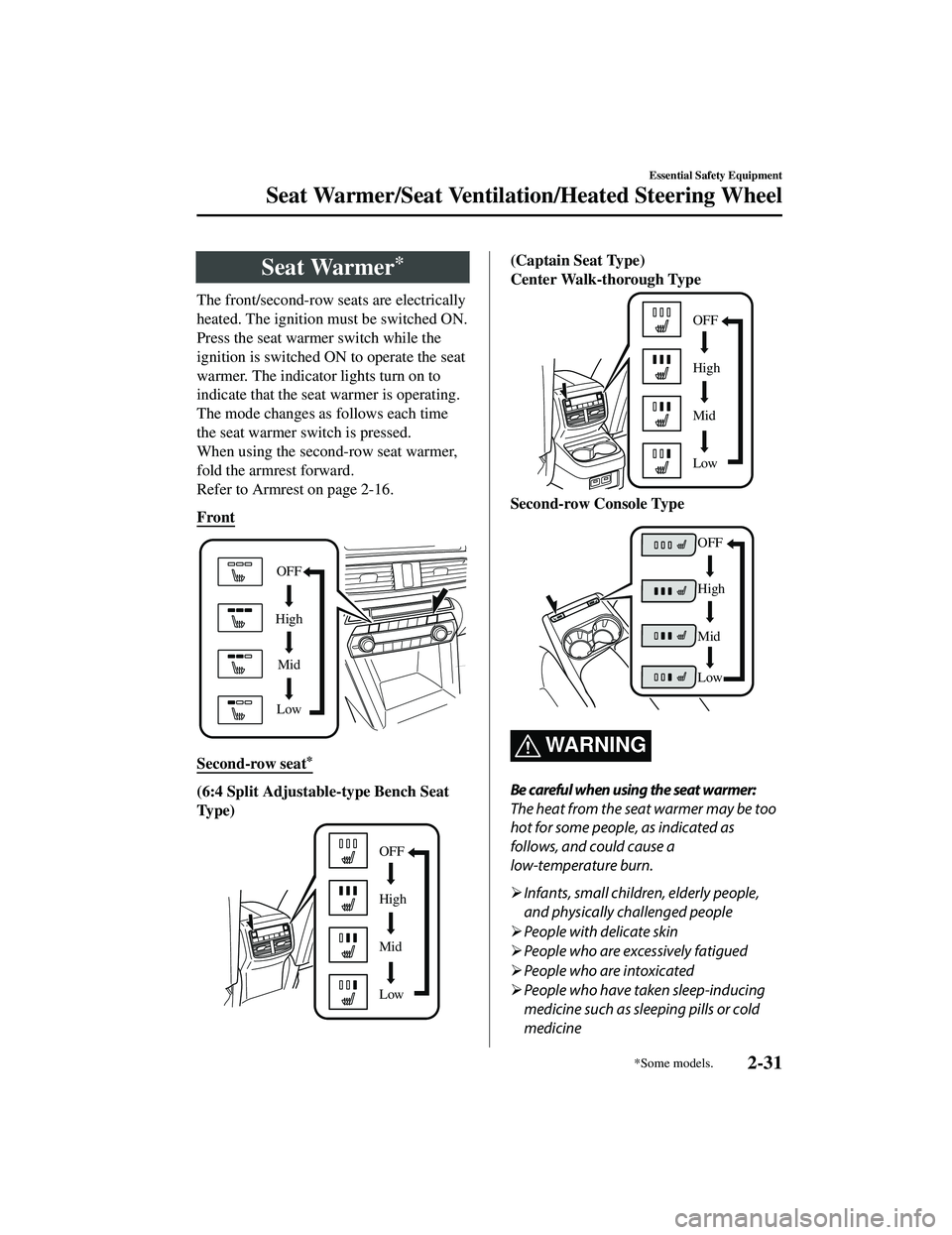
Seat Warmer*
The front/second-row seats are electrically
heated. The ignition must be switched ON.
Press the seat warmer switch while the
ignition is switched ON to operate the seat
warmer. The indicator lights turn on to
indicate that the seat warmer is operating.
The mode changes as follows each time
the seat warmer switch is pressed.
When using the second-row seat warmer,
fold the armrest forward.
Refer to Armrest on page 2-16.
Front
OFF
High Mid
Low
Second-row seat*
(6:4 Split Adjustable-type Bench Seat
Ty p e )
(Captain Seat Type)
Center Walk-thorough Type
OFF
High
Mid
Low
Second-row Console Type
OFF
High
Mid
Low
WA R N I N G
Be careful when using the seat warmer:
The heat from the seat warmer may be too
hot for some people, as indicated as
follows, and could cause a
low-temperature burn.
Infants, small child ren, elderly people,
and physically challenged people
People with delicate skin
People who are excessively fatigued
People who are intoxicated
People who have taken sleep-inducing
medicine such as sleeping pills or cold
medicine
Essential Safety Equipment
Seat Warmer/Seat Ventilati on/Heated Steering Wheel
*Some models.2-31
CX-9_8JK1-EA-20G_Edition6_old 2021-12-8 9:30:44
Page 48 of 723

Seat Belt Precautions
Seat belts help to decrease the possibility of severe injury during accidents and sudden
stops. Mazda recommends that the driver and all passengers always wear seat belts.
(Except Mexico)
All of the seat belt retractors are designed to keep the lap/shoulder belts out of the way when
not in use.
The driver's seat belt has no provisions for child-restraint systems and has only an
emergency locking mode. The driver may wear it comfortably, and it will lock during a
collision.
However, the front passenger's seat and all re ar lap/shoulder belt retractors operate in two
modes: emergency locking mode, and for child-restraint systems, automatic locking mode.
While we recommend you put all children in the rear seats, if you must use the front
passenger seat for a child, slide the front passenger seat as far back as possible and make
sure any child-restraint system is secured properly.
(Mexico)
All the seats have lap/shoulder belts. These belts have retractors with inertia locks that keep
them out of the way when not in use. The lo cks allow the belts to remain comfortable on
users, but they will lock in position during a collision.
WARNING
Always wear your seat belt and make sure all occupants are properly restrained:
Not wearing a seat belt is extremely dangerou s. During a collision, occupants not wearing
seat belts could hit someone or things inside the vehicle or even be thrown out of the vehicle.
They could be seriously injured or even killed. In the same collision, occupants wearing seat
belts would be much safer.
Do not wear twisted seat belts:
Twisted seat belts are dangerous. In a collision, the full width of the belt is not available to
absorb the impact. This puts more force on the bones beneath the belt, which could cause
serious injury or death. So, if your seat belt is twisted, you must straighten the seat belt to
remove any twists and to allow the full width of the belt to be used.
Never use one seat belt on more than one person at a time:
Using one seat belt for more than one person at a time is dangerous. A seat belt used in this
way cannot spread the impact forces properly and the two passengers could be crushed
together and seriously injured or even killed. Ne ver use one belt for more than one person at a
time and always operate the vehicle wi th each occupant properly restrained.
Essential Safety Equipment
Seat Belt Systems
2-35
CX-9_8JK1-EA-20G_Edition6_old 2021-12-8 9:30:44
Page 50 of 723

▼Pregnant Women and Persons wi
th Serious Medical Conditions
Pregnant women should always wear seat belts. Ask your doctor for specific
recommendations.
The lap belt should be worn SNUGLY AND AS LOW AS POSSIBLE OVER THE HIPS.
The shoulder belt should be worn across your shoulder properly, but never across the
stomach area.
Persons with serious medical conditions also should wear seat belts. Check with your doctor
for any special instructions regarding specific medical conditions.
▼Emergency Locking Mode
When the seat belt is fastened, it will
always be in the emergency locking mode.
In the emergency locking mode , the belt remains comfortable on the occupant and the
retractor will lock in position during a collision.
If the belt is locked and cannot be pulled out, retract the belt once, and then try pulling it out
slowly. If this fails, pull the belt strongly 1 time and loosen, then pull it out again slowly.
(Seat Belt with Auto matic Locking Mode)
When the seat belt is fastened, it will always be in the emergency locking mode until it is
switched to automatic locking mode by pulling it all the way out to its full length. If the belt
feels tight and hinders comfortable movement while the vehicle is stopped or in motion, it
may be in the automatic locking mode because the belt has been pulled too far out. To return
the belt to the more comfortable emergency lo cking mode, wait until the vehicle has stopped
in a safe, level area, retract the belt fully to convert it back to emergency locking mode and
then extend it around you again.
▼ Automatic Locking Mode*
Always use the automatic locking mode to keep
the child-restraint system from shifting to
an unsafe position in the event of an accident. To enable seat belt automatic locking mode,
pull it all the way out and connect it as instructed on the child-restraint system. It will retract
down to the child-restra int system and stay locked on it. See the section on child restraint
(page 2-44).
Essential Safety Equipment
Seat Belt Systems
*Some models.2-37
CX-9_8JK1-EA-20G_Edition6_old 2021-12-8 9:30:44
Page 53 of 723

Front Seat Belt
Pretensioner and Load Limiting Systems
For optimum protection, the driver and
front passenger seat belts are equipped
with pretensioner and load limiting
systems. For both these systems to work
properly you must wear the seat belt
properly.
Pretensioners:
When a collision is detected, the
pretensioners deploy simultaneously with
the air bags.
For vehicles with the front passenger
occupant classification system, the
pretensioners deploy simultaneously with
the air bags when a roll-over is also
detected.
For deployment details, refer to the SRS
Air Bag Deployment Criteria (page
2-82).
The front seat belt retractors remove slack
quickly as the air bags are expanding. Any
time the air bags and seat belt
pretensioners have fired they must be
replaced.
A system malfunction or operation
conditions are indicated by a warning.
Refer to Taking Action on page 7-37.
Refer to Air Bag/Front Seat Belt
Pretensioner System Warning Beep on
page 7-47.
(With Front Passenger Occupant
Classification System)
In addition, the preten sioner system for the
front passenger, like the front and side
passenger air bag, is designed to only
deploy when the front passenger occupant
classification sensor detects a passenger
sitting on the front passenger's seat.
For details, refer to the front passenger
occupant classification sensor (page
2-85).
Load limiter:
The load limiting system releases belt
webbing in a controlled manner to reduce
belt force on the occupant's chest. While
the most severe load on a seat belt occurs
in frontal collisions, the load limiter has an
automatic mechanical function and can
activate in any accident mode with
sufficient occupant movement.
Even if the pretensioners have not fired,
the load limiting function must be checked
by an Authorized Mazda Dealer.
WA R N I N G
Wear seat belts only as recommended in
this owner's manual:
Incorrect positioning of the driver and front
passenger seat belts is dangerous. Without
proper positioning, the pretensioner and
load limiting systems cannot provide
adequate protection in an accident and
this could result in serious injury. For more
details about wearing seat belts, refer to
"Fastening the seat belts" (page 2-38).
Essential Safety Equipment
Seat Belt Systems
2-40
CX-9_8JK1-EA-20G_Edition6_old 2021-12-8 9:30:44
Page 69 of 723

Always follow the instruction manual
accompanying the child-restraint system.
Anchor bracket location
Use the indicated anchor bracket locations
when installing a child-restraint system
equipped with a tether.
For right
For center
For left
Second-row seat
* *
Except Mexico
Third-row seat
Some models.
WA R N I N G
Always attach the tether strap to the
correct tether anchor position:
Attaching the tether strap to the incorrect
tether anchor position is dangerous. In a
collision, the tether strap could come off
and loosen the child-restraint system. If the
child-restraint system moves it could result
in death or injury to the child.
Always remove the head restraint and
install child-restraint system (Second-row
seat):
Installing a child-restraint system without
removing the head restraint is dangerous.
The child-restraint system cannot be
installed correctly which may result in
death or injury to the child in a collision.
Tether strap
Forward
Second-row
outboard seat
Tether strap
Forward
Second-row
center seat
Always install the head restraint and adjust
it to the appropriate position after
removing the child-restraint system
(Second-row seat):
Driving with the head restraint removed is
dangerous as impact to the occupant's
head cannot be prevented during
emergency braking or in a collision, which
could result in a serious accident, injury or
death.
Refer to Head Restraints on page 2-28.
Essential Safety Equipment
Child Restraint
2-56
CX-9_8JK1-EA-20G_Edition6_old
2021-12-8 9:30:44
Page 70 of 723

Only use a tether anchor designed for the
second-row seats:
Using a third-row seat tether anchor on the
second-row seat is dangerous. The
child-restraint system cannot be installed
correctly which may result in death or
injury to the child in a collision.
Tether strap
Third-row seatSecond-row
outboard/center
Always route the tether straps to the sides
of the head restraint (Third-row seat):
Routing the tether straps on top of the
head restraint is dang
erous. In a collision
the tether straps could slide off the head
restraint and loosen the child-restraint
system. The child-restraint system could
move which may result in death or injury to
the child.
Tether strap
ForwardThird-row seat
▼Using Automatic Locking Mode
(Except Mexico)
Follow these instructions when using a
child-restraint system, unless you are
attaching a LATCH-equipped
child-restraint system
to the rear LATCH
lower anchors. Refer to “Using LATCH
Lower Anchor” (page 2-64).
NOTE
Follow the child-restraint system
manufacturer's instru ctions carefully. If
you are not sure whether you have a
LATCH system or tether, check in the
child-restraint system manufacturer's
instructions and follow them accordingly.
Depending on the type of child-restraint
system, it may use LATCH system instead
of seat belts or if the belt goes across the
child's chest, may recommend against
using automatic locking mode.
1. (Second-row seat)
Adjust the second-row seat position
using the following procedure.
Fold the second-row seatback
forward.
Raise the second-row seatback until
a click sound is heard and it is locked
in place.
2. Adjust the angle of the second-row seatback so that there is no gap
Essential Safety Equipment
Child Restraint
2-57
CX-9_8JK1-EA-20G_Edition6_old 2021-12-8 9:30:44